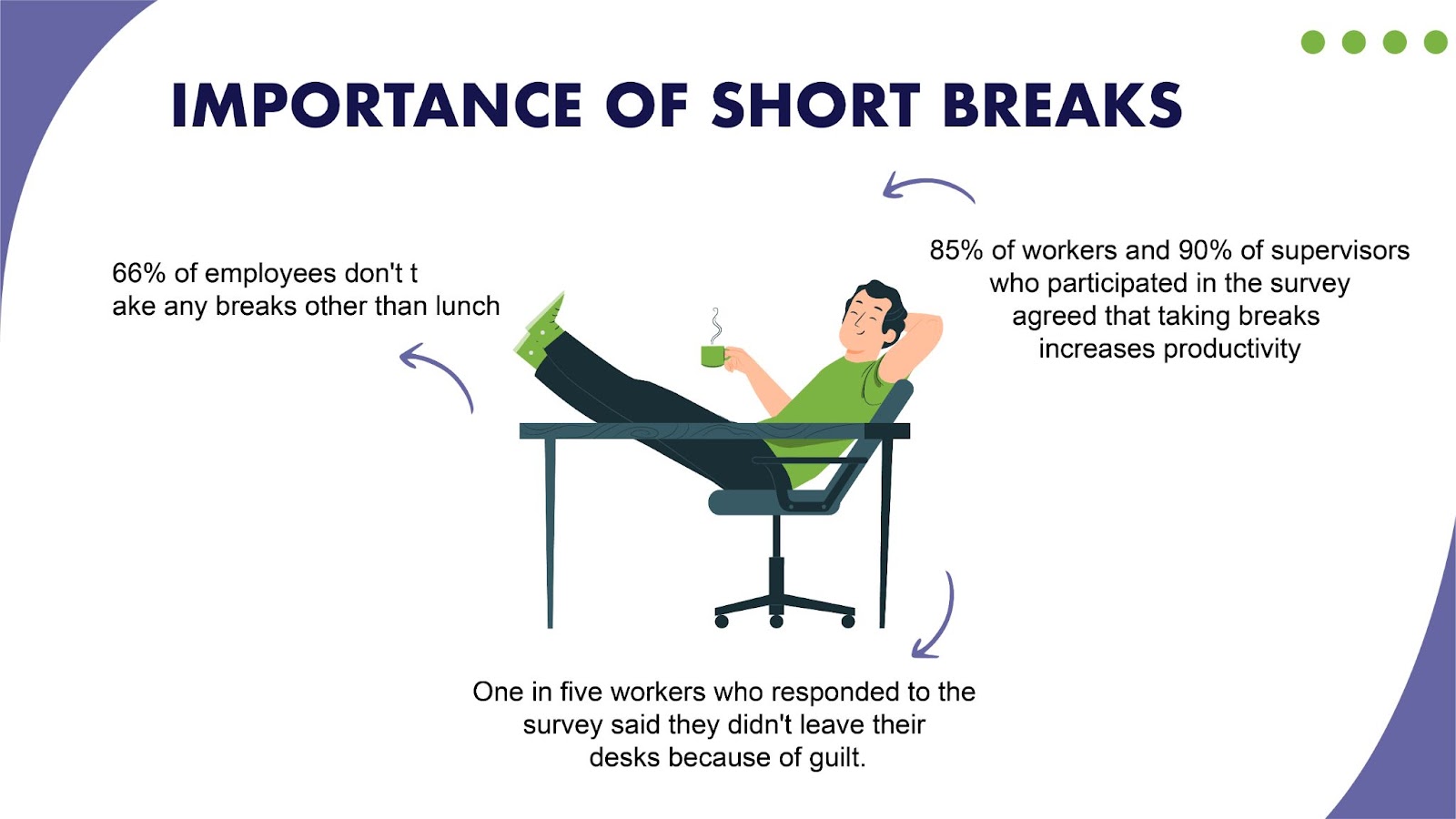You don't want to take a break right now, I get that. Why is that? Mostly because you're too occupied. You probably have a lot of tabs open on your phone or computer, including this one for this post. Your list of things to accomplish is likely nearby and full of items. Sometimes we are so busy that we don't even think we have the time to look for a better method to accomplish anything, so we just keep doing things the way we always have, even though we know there must be one.
I too perceive things in that way. I later learned the importance of taking breaks at work. They increased my happiness, clarity of thought, and productivity, and I guarantee they can do the same for you, whether you work in a cubicle or a corner office. Uncover the science behind why we need breaks at work, how to create your own master plan, and what to do on your well-earned break.

3 Scientific Reasons to Prioritize Work Breaks
1. Interruptions Prevent you from being Bored
The ideas come easily and you feel amazing when you're really into a task or endeavor. But it won't stay forever; if you push yourself a little bit past that point, you can become disoriented, drowsy, or even irritated. What changes?
Basically, the extended concentration we ask of the human brain today was not designed for it. Our brains have changed over time to keep an eye on a wide range of changes so that we can stay alive. Therefore, we will never be terrific at concentrating so intently on one item for a prolonged period of time (at least for a few centuries). The great news is that all we need is a little diversion (also known as a break) to get us back on track.
2. Memory Retention And Connection-Building
Research has demonstrated that daydreaming makes our brains fall into a latent state and that daydreaming actually makes multiple brain regions more active. Here is an example of a daydreamer's brain scan:
Daydreaming, which you may have done while driving or taking a shower, is thought to help the mind tackle its trickiest problems. Diffuse mode thinking frequently results in breakthroughs that appear to come from nowhere. In reality, concentration prevents you from entering the diffuse phase. And it turns out that you often need the diffuse mode to be able to deal with a very hard, brand-new problem.
3. Reevaluate Our Goals
The Harvard Business Review says that taking breaks gives us a chance to step back and make sure we are doing our jobs right. Continuous effort on a task makes it easy to lose focus and become bogged down in the details. On the other hand, picking up where you left off after a small break compels you to stop for a moment to consider your overall goals. It's a routine that helps us remember to keep our goals in mind.
How To Quit Being Guilty About Taking Breaks
Okay, so we know that taking breaks helps us get back our drive, focus, and sharpness But taking a break to go for a stroll or read during the workday? Can we really get past the remorse that will ensue?
In spite of spending more than eight hours a day at work—66% of employees do—more than half of them don't take any breaks other than lunch. One in five workers who responded to the survey said they didn't leave their desks because of guilt.
And that's despite the fact that 85% of workers and 90% of supervisors who participated in the survey agreed that taking breaks increases productivity! It has long been assumed that working nonstop will result in higher pay. People have always thought that working all the time would help them get more done, move up in their careers, and be more successful.
Testimonials of Successful Leaders
- According to Tony Schwartz, CEO of the New York City-based productivity consultancy company The Energy Project, "When the pressure in our lives escalates, we tend to burrow down and push harder." The issue is that without any breaks to rest and recharge, we become less productive, commit more errors, and lose interest in what we are doing.
- Tim Kreider defines breaks in The New York Times as follows: "Inactivity is not merely a holiday, a habit, or an indulgence; it is as paramount to the brain as vitamin D is to the body, and when we are deprived of it, we experience a mental illness”. Ironically, it’s essential to complete any task.
- The Energy Project aims to assist businesses in finding a more efficient way to work—including breaks. He has worked with many Fortune 500 firms, including Google, Apple, Facebook, Coca-Cola, Green Mountain Coffee, Ford, and Genentech. It sounds like a pleasant group!
The Science Of Taking A Break
If you're eager to attempt taking breaks at work but are unsure how to do so, keep reading. Here are a few approaches that you could use.
Pomodoro Technique
One of the most common ways to stick to a schedule with breaks, especially when you're busy, is to work in short bursts. The Pomodoro Technique is ideal in this situation. Get some fresh air, get a refreshment, or just unwind by stretching your legs. Take a lengthier break of about 30 minutes after completing four Pomodoro sessions.
Working over such short periods of time enables you to eliminate interruptions and concentrate more intently. I discovered that each chunk of work that I completed had a beginning and a finish, and I discovered that this gave me a slight sense of urgency. I completed chores more swiftly and made "small decisions" faster because I could see the time running out.
90-minute Work Blocks
Need more time to get started? Working in 90-minute blocks has long been a preferred strategy for boosting productivity. It is in accordance with our bodies' natural cycles.
The 90-minute pattern was first identified by sleep researchers William Dement and Nathan Kleitman when examining the cycles through which we enter sleep. However, it also exists when we are awake as we transition from higher to lower alertness levels. The top performers practiced in concentrated sessions lasting no longer than 90 minutes.
"People must avoid getting too tired, so they should only practice as much as they can fully recover from every day or every week."
52-17 Method
Third, combine Pomodoro and 90-minute time blocks, which research shows might be the most effective schedule of all. Using the time-tracking and productivity tool DeskTime, the Draugiem Group looked at how the most skilled workers spent their time at work. They discovered that these individuals work for 52 minutes at a time, take a 17-minute break, and then resume their job. Working with purpose was the key. This explains why the 10% of our customers who are the most productive are able to do the most in relatively short amounts of time.
They work hard for the entire 52 minutes, but they also take breaks to get ready for the next rush. In other words, they are acting deliberately. Pro tip: To stay on task while using any of these timed techniques, I like to add Focus Booster, a discreet and practical timer tool.
How Can Courses Help You Increase Productivity Levels?
However, studies have shown that taking a break may have extremely helpful for both you and your work. There is evidence that all types of breaks—including midday and longer ones—are beneficial for both productivity and well-being. Regular breaks will improve your performance.
Even though taking frequent breaks during the workday might not have as visible an effect as taking a vacation, research has identified important advantages. Breaks can help you work better all day, make it so you don't need a long time to rest at the end of the day, and reduce or even get rid of stress. According to a study, taking breaks during lunch and disconnecting from work boosts productivity and lessens fatigue. A year later, it was found that it gradually makes people stronger and gives them more energy.

